Whether your carnivorous plants are indoors or you live in an area where there are fewer bugs available, you may have decided it’s necessary to begin supplying them with some alternate food sources. However, effectively feeding a carnivorous plant varies depending on what kind it is, so let’s take a look at how to feed some of the more common types to prevent them from missing out on important nutrients.
Butterworts (Pinguicula)
Butterworts do a pretty good job of catching food on their own. If they seem to be having trouble though, sprinkle some fish food or bloodworms on a sticky leaf or two every 2-3 weeks. Try to keep food away from the sensitive crown though to minimize bacteria and mold growth.
Some butterworts will enter a succulent phase during certain times of the year. They will stop producing sticky leaves and the plant will usually shrink in size. There’s no need to feed butterworts during this time.
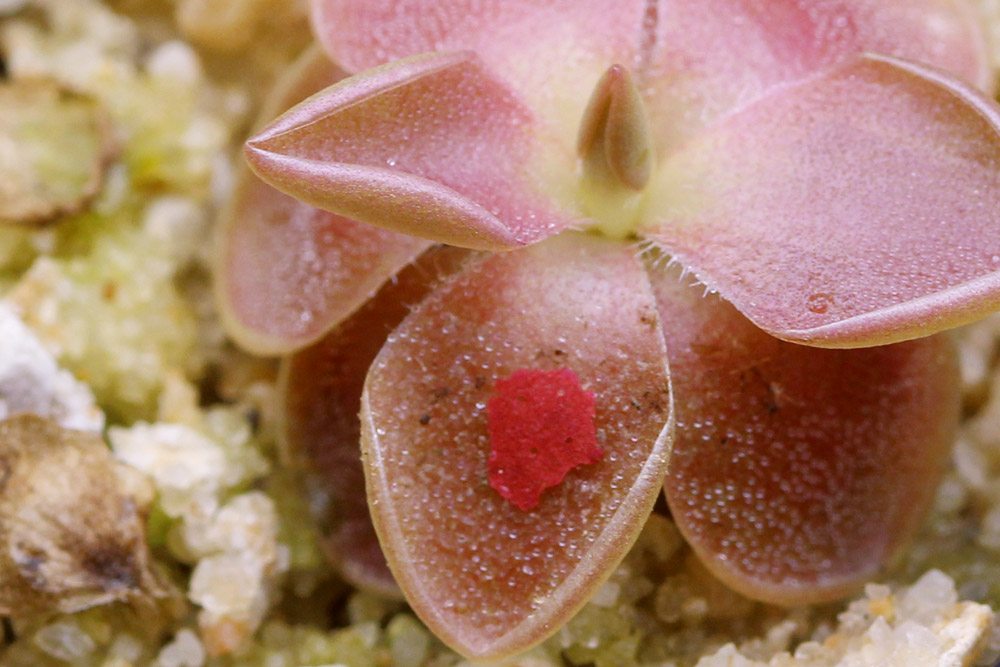
Butterwort with fish flake food
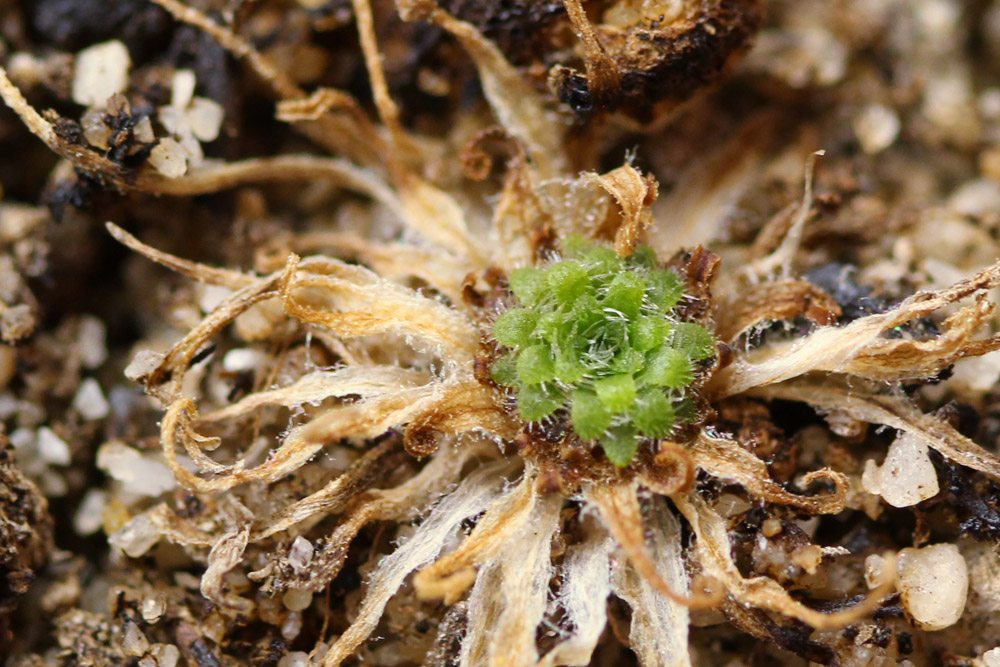
Butterwort in succulent phase
Pitcher Plants (Nepenthes, Sarracenia, & Cephalotus)
Pitcher Plants are probably the easiest carnivorous plants to feed. During their active growing season, drop bugs, fish food, or fertilizer pellets in a few of the pitchers every 2-3 weeks. If the pitchers are dry, squirt water in them with a pipette or eyedropper after feeding, otherwise they won’t be able to absorb the nutrients. If you move plants after the pitchers are full, do so carefully. Partially digested food from a spilled pitcher doesn’t smell the best.
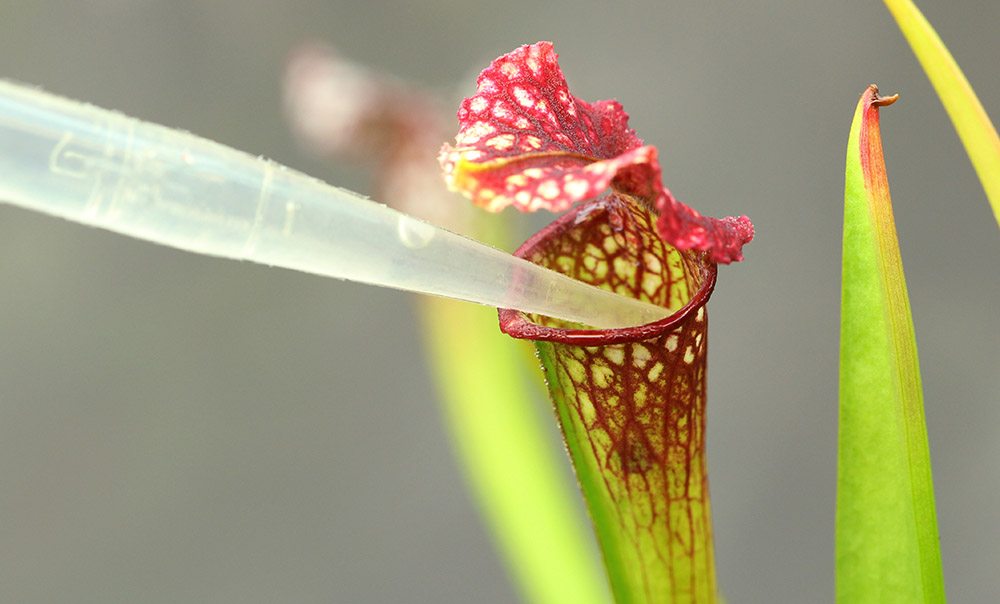
Adding water to a young Sarracenia pitcher
Sundews (Drosera)
Like butterworts, sundews do a pretty good job of catching food on their own. If they seem to be struggling though, feed a few dewy leaves dry fish food or bloodworms every 2-3 weeks. If you’re in a hurry, store the food in an old spice shaker and give it a few shakes over the plant occasionally. Just be careful not to pour too much out or get food near the crown of the plant.
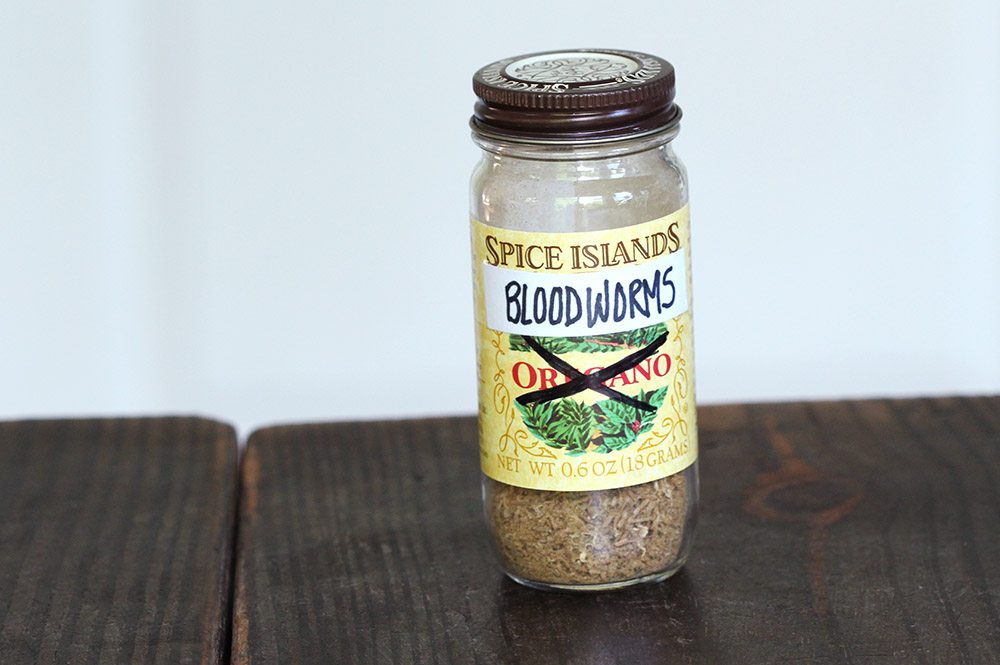
Mmm Bloodworms
If you’d like a more targeted approach, use a pair of pointed tweezers to stick food on the tentacles. After feeding, most sundews curl their leaves around prey within about 20 minutes. If a sundew doesn’t have dew on its tentacles, this could be a sign that it’s stressed. Only feed it after the dew returns.
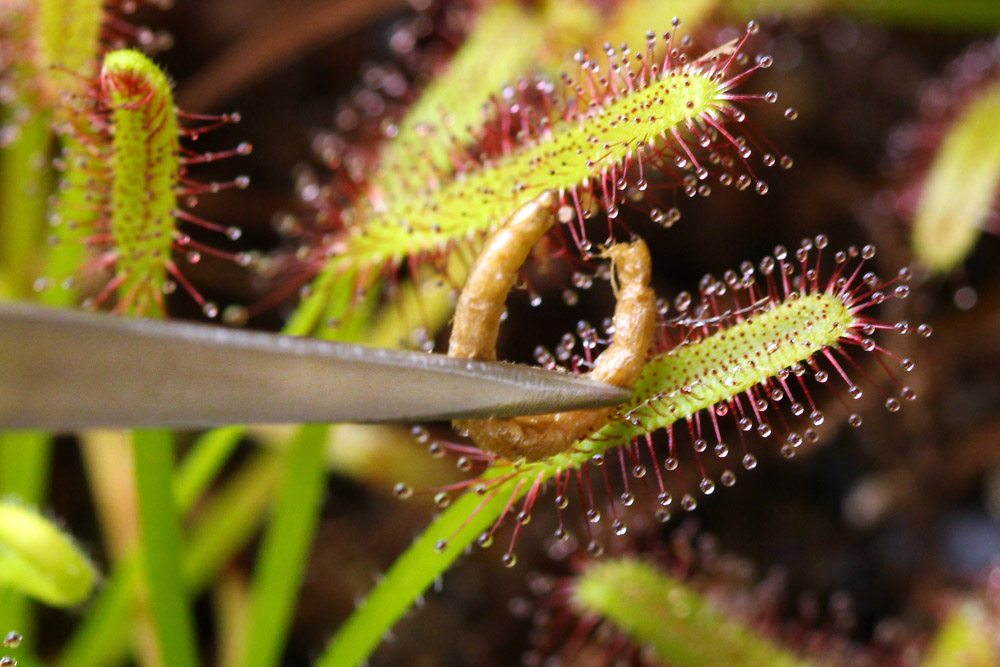
Tweezer feeding D. capensis a bloodworm
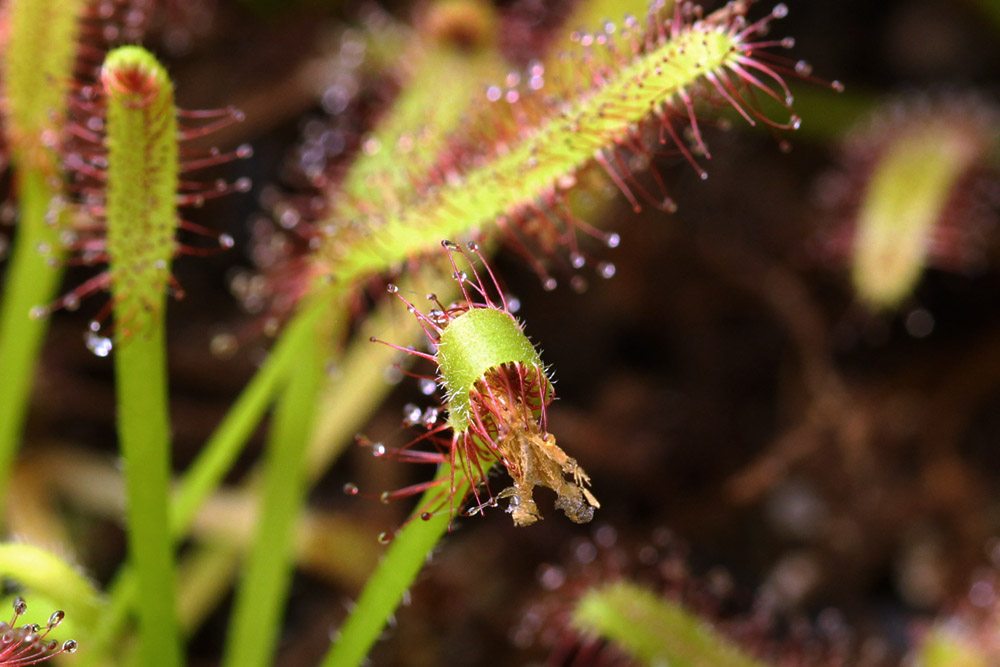
Leaf curl after about 20 minutes
Venus Flytraps (Dionaea)
Venus flytraps are some of the most fun carnivorous plants to feed! Using tweezers, gently brush a bug, damp fish food, or bloodworms against the trigger hairs inside one of the traps. The trap will snap shut after a couple of strokes, getting a mouthful of food. The amount of food you give each trap depends on its size. Generally, the size of the food should be about 1/4 of the size of the trap.
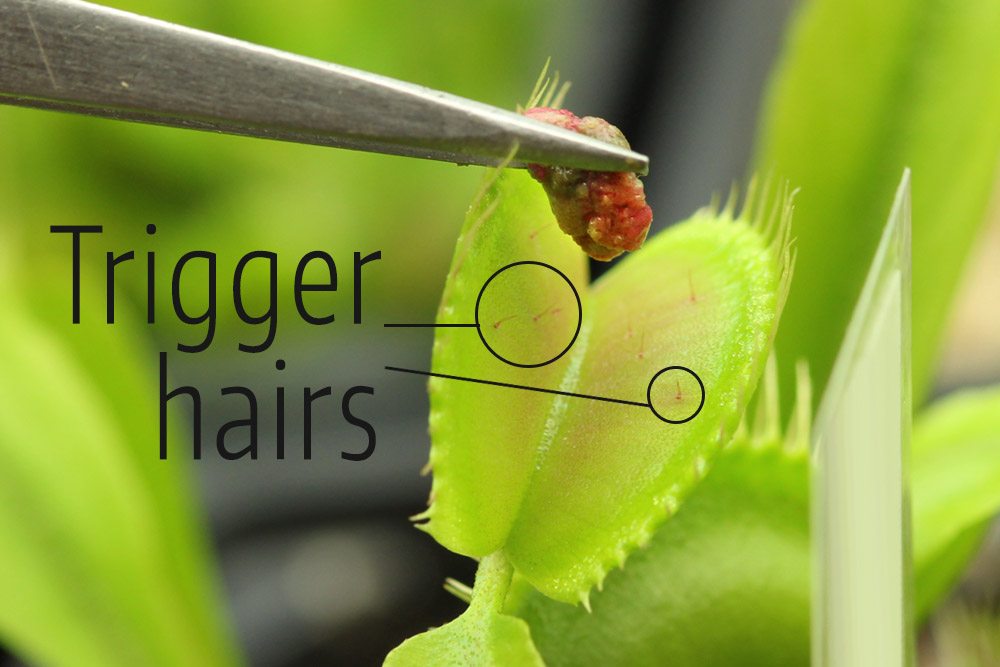
Tweezer feeding a Venus flytrap fish flakes
For food that isn’t fed live, gently massage the trap after it has snapped shut. This mimics a bug moving inside and stimulates the trap to seal more tightly and produce extra digestive enzymes. Learn more about this amazing process here. Feed a few traps every 2-3 weeks during the plant’s active growing season.

Massaging a trap to stimulate digestion
So Now What?
This guide gave a brief overview of how to feed carnivorous plants but if you haven’t done so already, check out our article: What to Feed Carnivorous Plants. It covers a variety of suitable food sources and alternatives to bugs. Thanks for reading and feel free to leave questions and comments below, we’d like to hear from you!

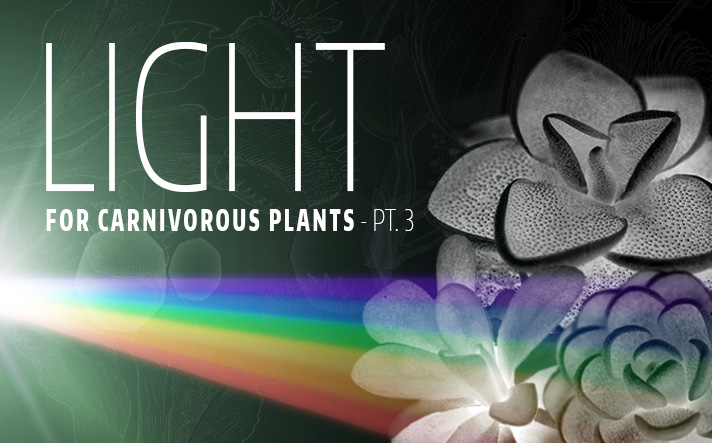
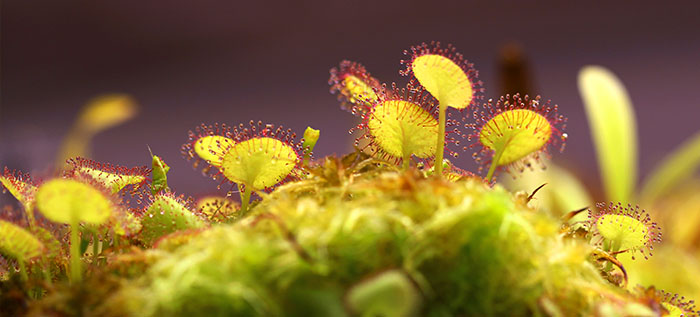

Thanks so much for this! I just bought both a Venus Flytrap and a Pitcher plant from the local nursery (Sorry! I didn’t know about you!)
The gal at the nursery told me they love to be in water (so they’re in a bowl with a little water) and they love the sun… They’re in the window that gets a lot of light, but it’s indirect sun.
1. Should I find a direct sunlight window?
2. My Venus flytrap is small but the largest of the group currently has 3 dead gnats and I cannot get it to trigger closed! Could it be full? If so, do I need to remove those gnats? The itty bitty ones seem to be opening and closing on a daily basis – I placed a piece of pluot between the pitcher and the Venus, to attract some fruit flies.
It’s only been 3 days. I’m sure I’m just being impatient? 🤷♀️
Happy to help Jody! Yes, direct is best for venus flytraps and pitcher plants (assuming Sarracenia). The flytrap that has the gnats in it may have been used several times already in which case it may no longer close. It sounds like the other traps are still functioning well though so I would just let it do it’s thing and it should continue to grow more traps to replace the old ones. Thanks!
Such great information! I am new to being a carnivorous plant mom and am curious as to when do I start feeding it in the pitcher? I grew my plant from rhizome (~ 8 was) and it has been doing great! It finally opened at the top this morning. Is it too early to feed it In it’s pitcher or since it is open, it is ready!?? Thanks in advance!
Hi Camaran, glad you found the information helpful! Yes if the pitcher is open, it’s ok to feed it :) Enjoy your plant babies!
I have a new baby H.Nutans (Pitcher Plant). They are about 2-3 inches. My question is : When do I start feeding them?
Hi Mary, the pitchers of young H. nutans can be a little challenging to feed since the openings to the pitchers are so narrow. We usually recommend spraying a diluted foliar fertilizer like Maxsea on the exterior of the pitchers a couple of times a month or squirting a few drops inside them. Once the pitchers get larger it becomes easier to feed them other types of food. I hope this helps!
I’ve had a pitcher plant in the past that lived long until I went on a 2 week trip and my husband gave it tap water. Anyway, I picked up an extremely small pitcher plant at a local nursery and the pot is extremely small and the pitchers it is growing since I got it are HUGE and tipping the pot over. I’m scared to death to transplant the plant since I never have before. Will it go into shock? Do you give it Vit B-1 like other plants to prevent this? (The pot is plastic, about 1 & 1/2 inches high)
Hi Margaret, your pitcher plant sounds very healthy! As long as you don’t disturb the roots too much during the transplant, it shouldn’t go into shock. Increasing the humidity temporarily can also help just to be extra safe :) Thanks!
My nepenthes pitcher plant’s pitcher has rotted away the following days after me feeding it. What could cause this problem and how can I fix it?
It’s a new pitcher as well, this is its first feeding since I got it from Lowe’s selection. If this information helps at all
Hi Tristan, pitchers rot can be due to a couple of things. First, the pitcher may have been close to the end of its life in which case they usually begin to turn papery and brown. If it rotted quickly from the bottom up and is mushy though, this usually means the pitcher had a little too much food to handle and it would be best to use smaller amounts. Thanks!
my venus fly trap did not seem healthy what do i do?
Hello, is this a flytrap you ordered from us? If so, please send us a message via the contact page with your order number and I’d be happy to look it up. Thanks!
I have some NEPENTHES pitcher plants. For some reason they stop Pitchering. What am i doing wrong?
Hi Clifford, low humidity is a common cause for Nepenthes to stop producing pitchers. You might check your levels to make sure they’re consistently at 50% or above.
my drosera has started turning black on the tips do you know why?
Hi Bob, blackening leaf tips can be caused by a number of things, including low humidity, lack of water, excess heat, aging leaves, or dormancy (depending on the species). I’d be happy to try and give you a more specific answer if you can provide more information about your conditions and the type of plant. Thanks!
I’ve been wondering what type of pitcher plant I have.How do i tell? Mine are small and look like they have red veins they also have red tips.
Hi Jill, from your description it sounds like you have a type of Sarracenia but as far as what kind, it would be hard to say without seeing a photo of it. If you’d like to get in touch via our contact page and send a picture, we’d be happy to take a look. Thanks!
Hi there! I feel my pitcher plan beta fish food (4-10 pellets) approx every 3 months. The pellets seem to mostly dissolve into a brown liquid that sits at the bottom of the pitcher. I recently fed the plant, adding new pellets into the pitchers containing the old pellet remains. Now white mold-looking stuff has developed in the pitchers. Have you seen this before? I’m tempted to cut those pitchers off if it’s bad for the plant, but perhaps it’s good?
Hi Heather, it sounds like your pitchers are doing a good job of breaking down the fish food pellets, lots of nutrients for the plant! A little mold inside won’t hurt anything but if you find it starts to cause premature rot in the pitcher walls then it may be helpful to trim them off and use a little less fish food next time so they don’t become overwhelmed. Thank you for your questions!